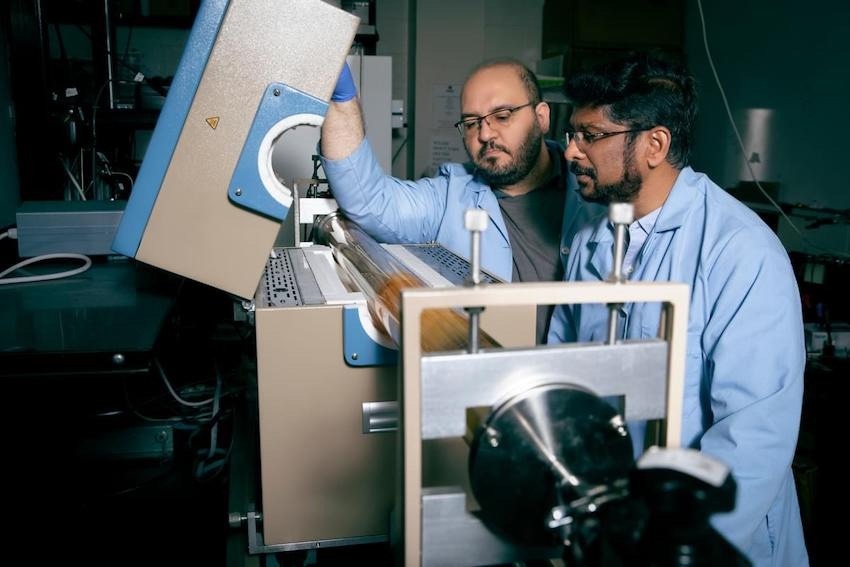Over a century ago, researchers found how to convert water into hydrogen gas, a highly looked-for green energy dubbed “the fuel of the future.”
 Navid Attarzadeh, left, and Ramana Chintalapalle, PhD, right, create a 3D nickel-based electrocatalyst to produce hydrogen from water. Image Credit: University of Texas El Paso
Navid Attarzadeh, left, and Ramana Chintalapalle, PhD, right, create a 3D nickel-based electrocatalyst to produce hydrogen from water. Image Credit: University of Texas El Paso
Despite this discovery, hydrogen has not found its place as a leading fuel source. The breakdown of water into hydrogen can be unsuccessful and expensive and the conversion procedure, known as electrolysis, stays unperfected.
Currently, engineers at The University of Texas at El Paso have suggested a cheap, nickel-based material to aid in splitting water more efficiently and economically. Their inspiration is a prickly pear cactus, which is a desert succulent. A new paper in the journal ACS Applied Materials & Interfaces explained this material.
This is nature-inspired design in the laboratory. You have this plant with an extensive surface that can absorb moisture and survive in extreme environments. We thought, ‘How can we incorporate this into our research?’
Ramana Chintalapalle, Ph.D., Study Lead Author and Professor, Mechanical Engineering, The University of Texas El Paso
The Hydrogen Problem
Electrolysis is the method to split water using electricity and an electrocatalyst, which is a material that expedites any chemical process. The existing techniques of splitting water depend mainly on platinum as a catalyst, which has its limitations.
Platinum is the dominant material used to help split water, but it is very expensive—more expensive than gold—and it’s just not feasible to use it on a large scale because of its price. We need a catalyst that’s more economically viable so every country can reasonably adopt hydrogen.
Ramana Chintalapalle, Ph.D., Study Lead Author and Professor, Mechanical Engineering, The University of Texas El Paso
A Prickly Solution
While walking to the Center for Advanced Materials Research lab of UTEP, Navid Attarzadeh first observed the prickly pear cactus. The research group had been exploring nickel as a catalytic substitute for platinum, which is a metal that is found in abundance on Earth and is 1,000 times more economical than platinum.
However, nickel is not as efficient and fast in splitting water into hydrogen.
Every day, I passed this same plant. And I started connecting it to our catalyst problem. What caught my attention was how big the leaves and fruits were compared to other desert plants; the prickly pear has an extraordinary surface area.
Attarzadeh, Doctoral Student, Environmental Science and Engineering, The University of Texas El Paso
Attarzadeh got an idea at that time. What if they developed a 3D nickel-based catalyst in the form of the prickly pear cactus? More electrochemical reactions can be accommodated by a larger surface area, forming more hydrogen than nickel usually could.
They immediately developed the nano-scale structure, which is not visible to the human eye, and put it to the test.
“We tested the catalyst’s ability to split water repeatedly and had good results,” Chintalapalle stated.
He also stated that this is a fundamental breakthrough and the process requires more refinement, but it is a step in the correct path.
“Hydrogen gas can transform energy technology for our country—without generating greenhouse gas emissions. Our carbon footprint could be eliminated; we need to keep pursuing this,” Chintalapalle concluded.
The study was funded by a grant from the National Science Foundation.
Journal Reference:
Attarzadeh, N., et al. (2023). Nature-Inspired Design of Nano-Architecture-Aligned Ni5P4-Ni2P/NiS Arrays for Enhanced Electrocatalytic Activity of Hydrogen Evolution Reaction (HER). ACS Applied Materials & Interfaces. doi.org/10.1021/acsami.3c00781.